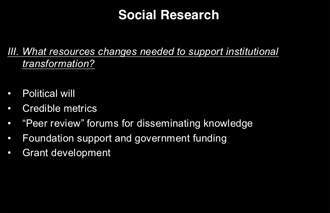|
|
Sherry Ahrentzen:
We can now revert, returning to the beginning of social research for a few moments. We were just dealing with research in architecture; all of these recommendations are really aggressive in that broader goal. In terms of the third question, we really pursued what resource changes would be needed to support institutional transformation. Underneath it all is political will. How that will would come about, we didn’t say. Whether it’s trying to leverage social capital resources or financial capital resources, you have to have the political will. There has to be a passion and a commitment that this is going to change and this is going to be effective. That’s one thing that we thought was really essential.
The second thing was the metrics that we use to measure the outcomes, to measure the importance of what we do. They have to be much more sophisticated and credible, not just to the people who are affected by it but also to the people who are looking to make changes in organizations and in environments, whether that’s a business community, public officials in different agencies, or whomever. Our metrics have to be much more sophisticated than many of them have been to date. We talked about having common metrics, and we all think there could be a process of looking at how to make more credible metrics.
Third, we discussed the term of a period, or a quorum, for disseminating knowledge. Not necessarily emulating an academic theory—theory not only in terms of judging the quality of a research paper or study but also its applicability, its use inspired with relevancy. Also not just thinking about presentations or just publications but also Web pages, workshops, or whatever else would aid in successful dissemination.
We also talked about foundation support and government funding. We always tend to think about government funding as being inflexible. The AIA and the profession could have more of a leveraging role for expanding government funding. A person cannot say “how” or “what” to NIH or HHS or UNICEF. For example, we need to consider how the word “environment” is used in environmental problems when you’re talking to the environmental health agency. How are the AIA’s and profession’s goal conveyed to them so that this is part of their agenda as well?
|
|

 |
There is also something that feels like an untapped resource that is really important: There are a lot of the foundations out there. For example, in the presentation yesterday, Matt O’Donnell talked about bioengineering and how that really became a field. He was saying they had the same problems with their research proposals 30 years ago. They sent it to NSF and nobody was going to fund it. They got a huge start from the Whitaker Foundation that funded all their research to begin with. They became much more acceptable after that, and the nature of the funding changed as well. McArthur Foundation, Kellogg Foundation—we should consider asking them, plus there are a lot of other foundations. We could start by thinking about making outreaches to them and getting some of those resources as well. The grant development could be not in terms of working just as individuals but also with the professions, or the collective, in trying to get some of these funds. |
>
01 02 03 04 05 |
